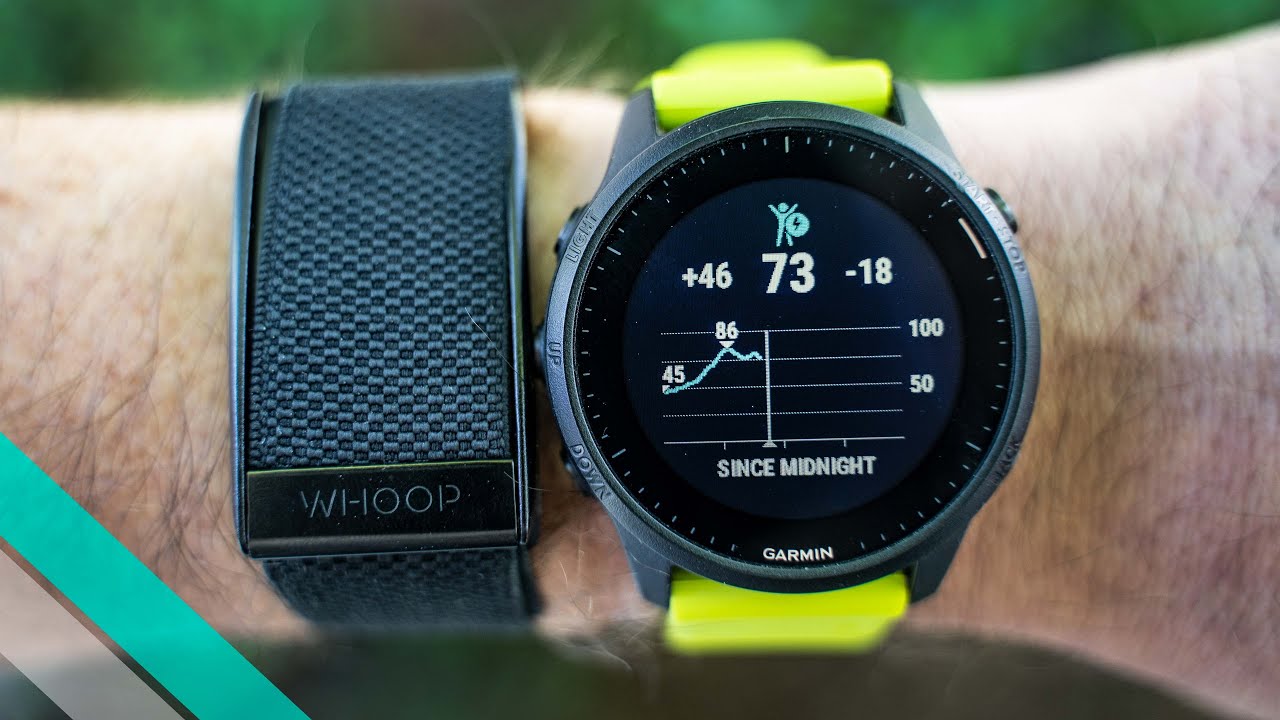Are you looking for a fitness tracker that optimizes your performance and well-being? Check out Whoop and Garmin, two of the best in the fitness tech industry.
In this post, I’ve compared both brands in terms of design, tracking capabilities, battery life, user interface, compatibility, and pricing. This comparison is perfect for both professional athletes and fitness enthusiasts.
Imagine having a device that provides personalized coaching, detailed sleep analysis, and advanced running metrics.
That’s what Whoop and Garmin can offer. With these devices, you can gain a new perspective on your health and fitness.
Let’s get started with the comparison –
Whoop Overview
Whoop, founded in 2012 by Will Ahmed, is a fitness technology company dedicated to helping users optimize performance, recovery, and well-being.
Their flagship product, the Whoop Strap, is a lightweight wearable device that continuously tracks key metrics like heart rate variability (HRV), resting heart rate (RHR), sleep patterns, and daily strain.
The Whoop app provides personalized coaching, goal setting, and community features.
With its data-driven approach, Whoop caters to professional athletes and fitness enthusiasts looking to improve their health and performance.
Garmin Overview
Garmin, founded in 1989, is a global leader in GPS technology and wearable devices, offering products like fitness trackers, smartwatches, and multisport GPS watches. Popular product lines include Forerunner, Fenix, Vivoactive, and Vivosmart.
The Garmin Forerunner 245 is a GPS running watch designed for all levels of runners.
Key features include built-in GPS, wrist-based heart rate monitoring, advanced running metrics, training status evaluation, customizable workouts, and smart notifications.
The Forerunner 245 showcases Garmin’s commitment to providing advanced, user-friendly fitness tracking devices.
Whoop vs Garmin Fitness Trackers: Design
Comfort: Whoop and Garmin fitness trackers prioritize comfort by using lightweight materials and adjustable bands. Whoop’s strap is designed for 24/7 wear, featuring a minimalistic design with no display, while Garmin offers a range of devices with varying levels of comfort depending on the model.
Durability: Garmin fitness trackers are generally built to withstand various physical activities and harsh environments, with some models featuring water resistance and rugged designs. Whoop devices are water-resistant and durable, designed for continuous wear in various conditions.
Aesthetics: Whoop’s design is sleek and minimalistic, focusing on function rather than appearance. On the other hand, Garmin offers a more extensive range of styles, from simple fitness bands to stylish smartwatches, catering to different aesthetic preferences.
Whoop vs Garmin Fitness Trackers: Tracking Capabilities
![]()
Health and Fitness Metrics
Whoop and Garmin devices track essential health and fitness metrics, such as heart rate, sleep, and burned calories.
Depending on the model, Garmin devices typically offer a broader range of tracking capabilities, including steps, distance, and advanced metrics like VO2 max and running dynamics.
Whoop focuses on recovery, strain, and sleep performance, giving users a daily recovery score to optimize training and rest.
Accuracy and Comprehensiveness
Garmin devices are known for their accuracy, particularly in GPS tracking and heart rate monitoring.
The comprehensiveness of tracking depends on the specific Garmin model, with higher-end devices offering more advanced metrics.
Whoop’s tracking system is also accurate and reliable, with a strong focus on recovery and strain metrics, providing users with actionable insights to improve their overall fitness and well-being.
Whoop vs Garmin Fitness Trackers: Battery Life
Whoop devices have a battery life of up to 5 days, depending on usage. The battery life is consistent due to the minimalistic design and lack of a display.
Depending on the model and features, Garmin devices have a wide battery life range.
Some basic fitness trackers can last up to 7 days, while advanced GPS watches can last up to 2 weeks in smartwatch mode or up to 36 hours in GPS mode.
Different features and uses can significantly affect battery life. For Garmin devices, GPS, heart rate monitoring, or other advanced features can drain the battery more quickly.
Display brightness and notification settings can also impact battery life for Whoop and Garmin devices.
Whoop vs Garmin Fitness Trackers: User Interface

Ease of Use
Whoop and Garmin apps offer intuitive user interfaces designed for easy navigation and quick access to essential features.
The Whoop app focuses on three main metrics (recovery, strain, and sleep), making it simple for users to understand their data.
Garmin’s app, Garmin Connect, offers a more comprehensive range of data and features but maintains user-friendliness with customizable dashboards and straightforward navigation.
Data Presentation
The Whoop app presents data using clear visuals and charts, emphasizing the daily recovery score and offering insights to help users optimize their training and rest.
Garmin Connect presents data in various charts, graphs, and maps, allowing users to dive deep into their metrics and analyze their performance over time.
Customization Options
Garmin Connect offers more customization options, including personalized workouts, training plans, and the ability to customize the device’s display and features.
The Whoop app is less customizable, focusing on its core metrics and providing actionable insights based on those metrics.
Whoop vs Garmin Fitness Trackers: Compatibility
Both Whoop and Garmin devices are compatible with iOS and Android smartphones, syncing data with their respective apps (Whoop app and Garmin Connect).
Additionally, both devices can integrate with popular third-party fitness apps, such as Strava and MyFitnessPal, allowing users to share data and participate in challenges or social features.
Regarding accessories, Garmin devices have a wide range of compatible accessories, including external heart rate monitors, foot pods, and bike sensors, depending on the device model.
Whoop’s compatibility with accessories is limited, as it focuses on its core tracking capabilities and does not support additional sensors.
Whoop vs Garmin Fitness Trackers: Pricing
Pricing Models
Whoop and Garmin have distinct pricing models. Whoop operates on a subscription-based model, with a monthly fee starting at $30 (with a 6-month minimum commitment).
The Whoop Strap 3.0 is included for free with the subscription, and users can continue their membership on a month-to-month basis after the initial commitment. Discounts are available for longer subscription plans (12 or 18 months).
Garmin devices have a one-time purchase price, with a wide range of prices depending on the model and features.
Basic fitness trackers can start around $100, while advanced GPS watches and smartwatches can range from $200 to over $600. Garmin Connect, the companion app, is free and does not require a subscription.
Subscription Services
Whoop’s subscription includes access to all features within the app, including detailed analytics, personalized recovery, strain, sleep recommendations, and community features.
Garmin does not require a subscription for its devices or app. Still, some advanced features or third-party integrations may require separate subscriptions (e.g., premium music services or advanced training platforms).
Warranty
Whoop devices are covered by a warranty for the duration of the subscription, with customer support available to address any issues.
Garmin devices typically come with a 1-year warranty (varies by region), with the option to purchase extended warranties or protection plans for an additional cost.
Concluding lines
In wrapping up, Whoop and Garmin offer unique benefits to enhance your fitness journey. If you’re after data-driven recovery insights, Whoop’s subscription service is worth considering.
On the other hand, Garmin’s diverse device range and advanced tracking capabilities could be your perfect match if you value versatility and customization.
Now, it’s your turn to decide. Do you value Whoop’s recovery focus or Garmin’s wide tracking capabilities?
Are you ready to commit to a subscription, or would you prefer a one-time purchase?
Don’t delay.
Evaluate your fitness objectives, think about your budget, and make a choice.
Get the fitness tracker that will help you hit your fitness goals today.



